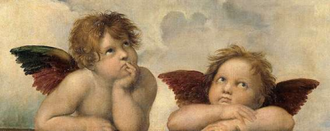Gospel in Art: Memorial of the Holy Guardian Angels

The Sistine Madonna, detail, Two Winged Putti, by Raphael © Gemäldegalerie Alte Meister, Dresden
Source: Christian Art
Gospel of 2 October 2024
Matthew 18:1-5, 10
The disciples came to Jesus and said, 'Who is the greatest in the kingdom of heaven?' So he called a little child to him and set the child in front of them. Then he said, 'I tell you solemnly, unless you change and become like little children you will never enter the kingdom of heaven. And so, the one who makes himself as little as this little child is the greatest in the kingdom of heaven.
'Anyone who welcomes a little child like this in my name welcomes me. See that you never despise any of these little ones, for I tell you that their angels in heaven are continually in the presence of my Father in heaven.'
Reflection on the painting
Today, we celebrate the Memorial of the Holy Guardian Angels. But what exactly are angels? We often speak of them and see them depicted, floating serenely in paintings, yet who are they in essence? St Augustine offers a profound insight: "Angel is the name of their office, not of their nature. If you seek the name of their nature, it is spirit; if you seek the name of their office, it is angel: from what they are, spirit; from what they do, angel." This is a succinct definition of a reality that can be difficult for us to fully comprehend.
The Catechism of the Catholic Church, in paragraph 350, sheds further light: "Angels are spiritual creatures who glorify God without ceasing and who serve His saving plans for other creatures. 'The angels work together for the benefit of us all'" (St. Thomas Aquinas, STh I, 114, 3, ad 3). This teaches us that angels are not merely passive beings; they are actively involved in God's divine plan.
Ok, but why do we specifically call them 'guardian' angels? This title reflects our belief that certain angels are assigned to protect and guide individuals, shielding them from harm and negative influences. These guardian angels are thought to intervene in moments of need, ensuring the safety and spiritual well-being of the people they are charged with guarding.
Some of the most famous angels ever painted are the two winged putti depicted in Raphael's Sistine Madonna. The Sistine Madonna depicts Mary holding the Christ Child, flanked by Saints Sixtus and Barbara. The figures are enveloped by soft clouds, suggesting a celestial realm. At the bottom of the canvas, two winged angels gaze upwards with thoughtful expressions. These angels are completely relaxed, playful and informal, with their arms resting on the edge of the frame, as though observing the scene above them. Their placement provides a counterbalance to the solemnity of the upper figures, introducing a sense of innocence and wonder. These angels have become widely recognised in their own right. They are very sweet indeed and are meant to subtly invite the viewer into the sacred narrative through their charming presence.
https://christian.art/daily-gospel-reading/matthew-18-1-5-10-2024/
LINKS
Gospel in Art: https://christian.art/
Today's Reflection: https://christian.art/daily-gospel-reading/matthew-18-1-5-10-2024/


















